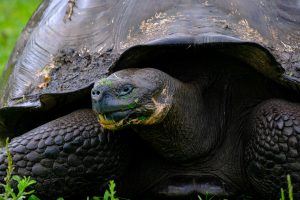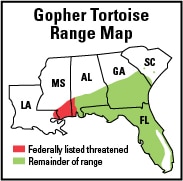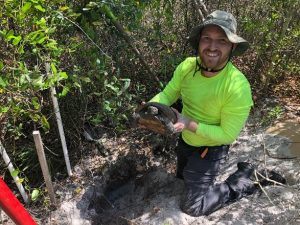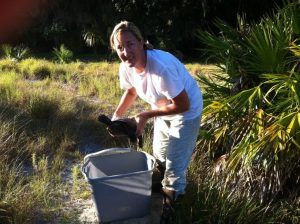It’s Peak Season for the Gopher Tortoise in Florida: Here’s What You Should Know
July 20, 2020
About the Gopher Tortoise

Gopher tortoise
Have you heard of the gopher tortoise? It is one of five North American tortoise species found in the southeastern Coastal Plain of the US (from southeast Louisiana to southern South Carolina, and south Florida).
Learn more about gopher tortoises.
Gopher Tortoise Behavior

Source: US Fish and Wildlife Service
Gopher tortoises can live 40 to 60 years in the wild and rely upon their burrows, where they spend up to 80% of their time. Many gopher tortoises use multiple burrows throughout their lives as they are ectotherms, meaning they depend upon their environment to maintain their body temperature. Their burrows maintain a stable temperature and humidity year-round, providing protection from the external environment. Due to its warm climate, tortoises are usually active year-round in Florida, though peak activity outside burrows occurs from May through August.
The breeding season occurs between March and October. Female gopher tortoises typically lay one clutch of 5-9 ping pong ball-sized eggs per year that are deposited between May and July.
Gopher Tortoise Threats

S&ME employee-owner, Taylor Wood, at a gopher tortoise relocation site in Florida.
The gopher tortoise’s primary threat is habitat loss through habitat destruction, fragmentation, and degradation, mostly due to urbanization and development. Land development for residential homes generally occurs in the same high, dry habitats that the tortoise prefers, so many burrows are found in these areas. Lack of appropriate land management is a contributor to population declines in areas where natural habitat remains.
In 1979, they became listed as a Species of Special Concern in Florida and were reclassified as a State-designated Threatened species in 2007. Read the Florida Fish and Wildlife Conservation’s first Gopher Tortoise Management Plan.
What To Do If You Have Gopher Tortoises On Your Property in Florida?

Employee-owner, Maria Summerlin, providing on-site relocation of a gopher tortoise through a Temporary Exclusion Permit for a major utility corridor in Florida. As part of the relocation, Maria ensures 20-30 min soaking of tortoise to prevent dehydration caused by the stress of moving.
In Florida, gopher tortoises are protected, meaning handling and relocation is illegal unless conducted under a valid permit issued by the Florida Fish and Wildlife Conservation Commission. Additionally, authorized gopher tortoise agents are permitted to survey, trap, mark, transport, and relocate gopher tortoises through a Temporary Exclusion Permit.
If you are developing within Florida gopher tortoise habitats, our authorized gopher tortoise agents in our Environmental Business Unit can help:
- Complete property due diligence to determine if you need to address gopher tortoises
- Provide all services to address gopher tortoises, including:
- 100% burrow surveys
- Relocation permitting tailored to the needs of the project
- Relocation by bucket trapping or mechanical excavation
Contact Us
 For more information on S&ME’s natural resources services, please contact Chuck Black.
For more information on S&ME’s natural resources services, please contact Chuck Black.
